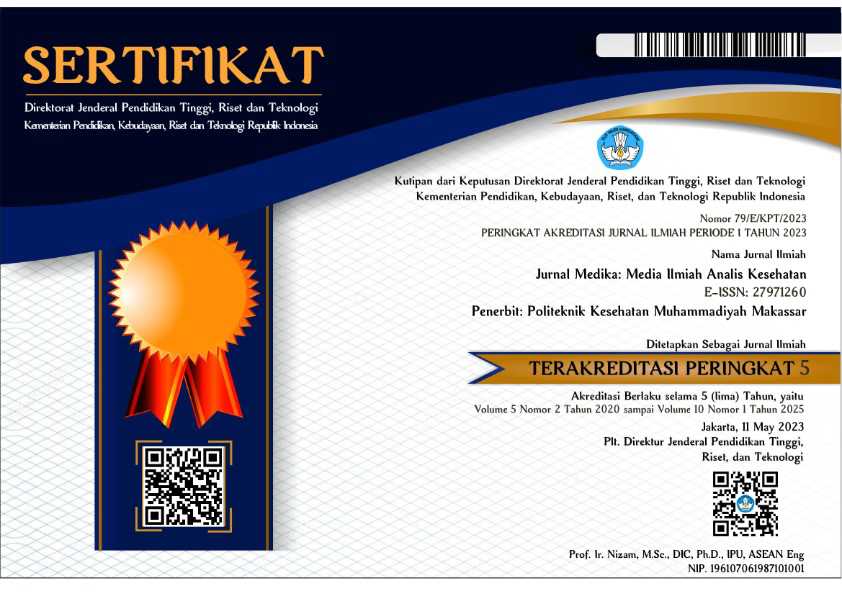PENGARUH BERBAGAI KONSENTRASI PERASAN JERUK NIPIS PADA PERTUMBUHAN Staphylococus aureus
Abstract
Staphylococcus aureus merupakan bakteri yang ditemukan pada kulit, saluran pernapasan, dan saluran pencernaan. Infeksi Staphylococcus aureus dapat diobati dengan pemberian antibiotik. Namun, penggunaan antibiotik dapat menyebabkan hipersensitivitas. Upaya untuk menghindari hipersensitivitas antibiotik yaitu dengan cara pemanfaatan tanaman sebagai alternatif antibiotik. Tanaman yang digunakan untuk pengobatan salah satunya adalah jeruk nipis (Citrus aurantifolia). Tujuan penelitian ini adalah untuk mengkaji pengaruh berbagai konsentrasi perasan jeruk nipis pada pertumbuhan Staphylococcus aureus. Parameter pertumbuhan Staphylococcus aureus ditetapkan dengan menghitung jumlah koloni menggunakan metode hitung cawan (plate count) setelah pemberian perasan jeruk nipis pada konsentrasi 25%, 50%, 75%, dan 100%. Hasil penelitian menunjukkan berbagai konsentrasi perasan jeruk nipis berpengaruh pada jumlah koloni Staphylococcus aureus. Perasan jeruk nipis konsentrasi 75% efektif dalam menurunkan jumlah koloni Staphylococcus aureus.
References
Chambers, H. F. and Deleo, F. R. (2009) ‘Waves of resistance: Staphylococcus aureus in the antibiotic era.’, Nature reviews. Microbiology, 7(9), pp. 629–41. doi: 10.1038/nrmicro2200.
Chusniah, I. and Muhtadi, A. (2017) ‘Review Artikel : Aktivitas Jeruk Nipis (Citrus aurantifolia) Sebagai Antibakteri, Antivirus, Antifungal, Larvasida dan Athelmintik’, Farmaka, 15(2), pp. 9–22.
Cushnie, T. P. T. and Lamb, A. J. (2005) ‘Antimicrobial activity of flavonoids’, International Journal of Antimicrobial Agents, 26(5), pp. 343–356. doi: 10.1016/j.ijantimicag.2005.09.002.
Dalimartha, S. (2008) Atlas Tumbuhan Obat Indonesia jilid 5. Jilid 4. Puspa Swara.
Dong, S. et al. (2020) ‘Antibacterial activity and mechanism of action saponins from Chenopodium quinoa Willd. husks against foodborne pathogenic bacteria’, Industrial Crops and Products, 149, p. 112350. doi: 10.1016/j.indcrop.2020.112350.
Dwiyanti, R. D. et al. (2018) ‘Efektivitas Air Perasan Jeruk Nipis (Citrus aurantifolia) dalam Menghambat Pertumbuhan Escherichia coli’, Jurnal Skala Kesehatan, 9(2). doi: 10.31964/jsk.v9i2.161.
El-Hadedy, D. and Abu El-Nour, S. (2012) ‘Identification of Staphylococcus aureus and Escherichia coli isolated from Egyptian food by conventional and molecular methods’, Journal of Genetic Engineering and Biotechnology, 10(1), pp. 129–135. doi: 10.1016/j.jgeb.2012.01.004.
Del Giudice, P. (2020) ‘Skin infections caused by staphylococcus aureus’, Acta Dermato-Venereologica, 100(100-year theme Cutaneous and genital infections), pp. 208–215. doi: 10.2340/00015555-3466.
Handoko and Yuliana, F. (2014) ‘Stability Study of Antibacterial Activity of Mixed Lime Juice and Honey of Heating Temperature on Staphylococcusaureus and Streptococcuspyogenes’, 21(2), pp. 1–7.
Katzung, B. G. 2015 (2015) Handbook Farmakologi Dasar dan Klinik. 4th edn. Penerbit Buku Kedokteran EGC.
Leboffe J. Michael & Pierce E. Burton (2011) A Photographic Atlas for the Microbiology Laboratory. 4th edn, Morton Publishing Company. 4th edn. Edited by D. N. Morton. colorado: morton publishing. doi: 10.2174/187152008785133128.
Lingga, R. A., Pato, U. and Rossi, E. (2016) ‘Uji Anti Bakteri Ekstrak Batang Kecombrang (Nicolaia speciosa Horan) Terhadap Staphylococcus aureus dan Escherichia coli’, Jom Faperta, 3(2), pp. 33–37.
McAdow, M., Missiakas, D. M. and Schneewind, O. (2012) ‘Staphylococcus aureus secretes coagulase and von willebrand factor binding protein to modify the coagulation cascade and establish host infections’, Journal of Innate Immunity, 4(2), pp. 141–148. doi: 10.1159/000333447.
Mustafa, H. S. I. (2014) Staphylococcus aureus Can Produce Catalase Enzyme When Adding to Human WBCs as a Source of H2O2 Productions in Human Plasma or Serum in the Laboratory’, Open Journal of Medical Microbiology, 04(04), pp. 249–251. doi: 10.4236/ojmm.2014.44028.
Nugraha, A. C., Prasetya, A. T. and Mursiti, S. (2017) ‘Isolasi, Identifikasi, Uji Aktivitas Senyawa Flavonoid Sebagai Antibakteri Dari Daun Mangga’, Indonesian Journal of Chemical Science, 6(2), pp. 91–96.
Oikeh, E. I. et al. (2016) ‘Phytochemical, antimicrobial, and antioxidant activities of different citrus juice concentrates’, Food Science and
Nutrition, 4(1), pp. 103–109. doi:
1002/fsn3.268.
Okwu, D. E. (2008) ‘Citrus fruits: A rich source of phytochemicals and their roles in human health’, International Journal of Chemical Sciences, 6(2), pp. 451–471. Available at: http://www.sadgurupublications.com/ContentPaper/2008/1_6(2)2008.pdf.
Pollack, R. A. (2018) Lab Exercises in Microbiology. 5th edn. wiley.
Prastiwi, S. S. and Ferdiansyah, F. (2013) ‘KANDUNGAN DAN AKTIVITAS FARMAKOLOGI JERUK NIPIS (Citrus aurantifolia s.)’, Farmaka, 15(2), p. 2.
Razak, A., Djamal, A. and Revilla, G. (2013) ‘Uji Daya Hambat Air Perasan Buah Jeruk Nipis (Citrus aurantifolia s.) Terhadap Pertumbuhan Bakteri Staphylococcus Aureus Secara In Vitro’, Jurnal Kesehatan Andalas, 2(1), p. 05. doi: 10.25077/jka.v2i1.54.
Rosyidah, K. et al. (2010) ‘Dari Kulit Batang Tumbuhan Kasturi’, BIOSCIENTIAE, 7(2), pp. 25–31.
Sumono, A. and SD, A. W. (2008) ‘The use of bay leaf (Eugenia polyantha Wight) in dentistry’, Dental Journal (Majalah Kedokteran Gigi), 41(3), p. 147. doi: 10.20473/j.djmkg.v41.i3.p147-150.
Tong, S. Y. C. et al. (2015) ‘Staphylococcus aureus infections: Epidemiology, pathophysiology, clinical manifestations, and management’, Clinical Microbiology Reviews, 28(3), pp. 603–661. doi: 10.1128/CMR.00134-14






